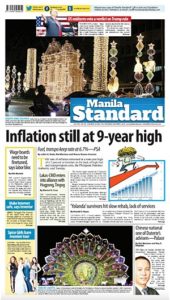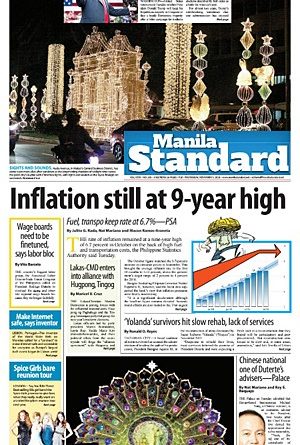Aseanews Headlines: MANILA- Inflation still at 9-year high – Fuel, transpo keep rate at 6.7% – PSA
The rate of inflation remained at a nine-year high of 6.7 percent in October on the back of high fuel and transportation costs, the Philippine Statistics Authority said Tuesday.
.

The October figure matched the 6.7-percent increase in consumer prices in September. This brought the average inflation rate in the first 10 months to 5.13 percent, above the government’s target range of 2 percent to 4 percent for 2018.Bangko Sentral ng Pilipinas Governor Nestor Espenilla Jr., however, said the latest data supported the bank’s view that inflation pressures were finally moderating.
.
READ: October inflation rate likely slowed to 6.5%
.
ADS by Cloud 9:
.
– SPACE RESERVE FOR YOUR ADVERTISEMENT –
.
“It is a significant deceleration although the headline figure remains elevated. Second-round effects are also muted so far. That augurs well for a return to inflation target by 2019,” Espenilla said in a message to reporters.He said the policy-making Monetary Board would take into account the latest inflation number and other incoming data including the gross domestic product growth in the third quarter set to be released this week during the next policy meeting this month “when it determines if there is still need for further policy rate adjustments.”Data from the PSA showed that while the year-on-year headline inflation was steady at 6.7 percent, seasonally adjusted month-on-month inflation eased further to 0.3 percent.PSA undersecretary and civil registrar general Lisa Grace Bersales said in a news briefing that mixed movements in the annual growths were posted among the commodity groups. She said the higher annual increases were observed in the indices of transport, 8.8 percent; housing, water, electricity, gas and other fuels, 4.8 percent; health, 4.3 percent; recreation and culture, 3.1 percent; and restaurant and miscellaneous goods and services, 4.2 percent.Bersales said the slowdown in the annual increments was seen in the indices of food and non-alcoholic beverages at 9.4 percent and alcoholic beverages and tobacco at 21.6 percent.“The annual rate of the food index decelerated to 9.2 percent in October 2018. Its annual growth in the previous month was 9.7 percent and in October 2017, 3.4 percent,” Bersales said.She said amid the government’s implementation of different measures to tame inflation, the unchanged inflation in October could be attributed in part to the impact of typhoon Ompong that mostly struck provinces in northern Luzon in the middle of September
.
ADS by Cloud 9:
.
– SPACE RESERVE FOR YOUR ADVERTISEMENT –
.
“We noted the damaged areas reported higher inflation,” Bersales said.Bersales said Typhoon “Rosita’s” impact might be felt in the November inflation rate, if it had any impact at all.Nicholas Mapa, senior economist of ING Bank NV Manila branch, said while price pressures abated somewhat, inflation remained elevated.“The 6.7-percent print validates the earlier expectation that inflation was close to or had peaked for the year and is now expected to taper off slowly going into the year-end. Measures undertaken by the government to address supply chain bottlenecks appear to have found their way to tag prices, alleviating some pressure on food prices but inflation remains sticky given supply constraints,” Mapa said.The government’s economic team said concerted efforts, as prescribed in Administrative Order 13, to tame the prices of goods in the previous months had finally resulted in expected outcomes.“The economic team is mindful that much attention has to be given to food, which remains to be the major contributor to inflation even as its price decelerates. To hasten the decline in consumer prices, the government must continue enforcing mitigating measures, particularly interventions in the food supply, one of which is rice,” it said.“To compensate for the lost harvest in typhoon-affected areas, rice imports should be closely monitored to ensure that their arrival is timely and sufficient,” the economic team said.The government said rice imports, along with the rice inventory of the National Food Authority, continued to improve with the completion of the government-to-government procurement and the first phase of 2018 Minimum Access Volume.“We also call on concerned government agencies, especially the Department of Agriculture, to speed up initiatives to distribute seed buffer stocks for rice, as well as corn and other high-value crops, in disaster-stricken areas in time for the planting season this November to January,” the team said.
.
ADS by Cloud 9:
.
– SPACE RESERVE FOR YOUR ADVERTISEMENT –
.
“Interventions in rice production should be supported by policies that will further ease food supply, which remains crucial as demand for food items is expected to increase with the onset of the holiday season. Congress must pass the long-overdue amendments to the Agricultural Tariffication Act, which is expected to reduce rice prices by P2 to as much as P7 per kilo,” it said.“Setting our sights on longer horizons more should be done to ensure price stability of food products. The government needs to pay closer attention to the agriculture and fisheries sector to significantly increase productivity and to be more competitive and resilient to weather-related and man-made shocks,” it said.The Palace, too, put a positive spin on the 6.7-percent inflation rate in October.“Well, the fact that it did not go up, should be a good news,” said Presidential Spokesman Salvador Panelo.He said the government, recognizing that certain global conditions affect the track of inflation, still hopes the figure will decrease in the next few months.The Palace official said the anti-inflation measures ordered by the President have tempered the increase in prices.“You must remember that we flooded the market with food supply—that’s one. And then the Department of Finance said that they will be reducing the expenditure of the government among others,” he said.“Apparently, the measures undertaken by the government have affected the inflation rates, so we will maintain that,” he added.Senate President Pro Tempore Ralph Recto said he remained optimistic that the inflation rate would decline soon, with rice and oil prices on the way down and the exchange rate strengthening.“Inflation is expected to decline soon,” said Recto. Although oil prices are volatile, he said it could increase if the United States pressures both China and India and a few other countries to stop importing from Iran.And if that happens, Recto said the exchange rate may weaken once again.He said Congress will pass rice tarrification within the year, which should further bring down inflation.“But we must ensure that all duties collected be used to assist our farmers increase productivity,” said the Senate leader.Senator Paolo Benigno Aquino IV said the government must work to help Filipinos still suffering from high prices of food and other goods with inflation unchanged.“Prices are still high and the Filipinos are still hurting. Let us give them comfort this coming Christmas,” said Aquino, one of four senators who voted against the ratification of the Tax Reform for Acceleration and Inclusion Law.Let us all help to suspend and rollback petroleum taxes. Let us pass in Congress the Bawas Presyo Bill and fix the TRAIN Law,” added Aquino who filed Senate Bill No. 1798 or the Bawas Presyo sa Petrolyo Bill last May.Aquino renewed his call to the government to support his measure, which he believes could help lower prices of petroleum products and the prices of goods in the market.READ: September inflation jumps to 6.7%
.
ADS by Cloud 9:
.
– SPACE RESERVE FOR YOUR ADVERTISEMENT –
.
Related stories:
.
ADS by Cloud 9:
.
– SPACE RESERVE FOR YOUR ADVERTISEMENT –
.



















